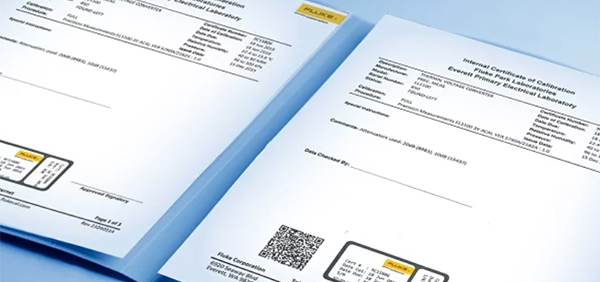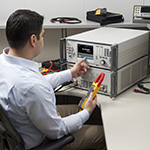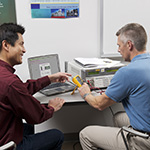- その他のフルークグループ:
- Fluke
- Fluke Biomedical
- Fluke Networks
- Fluke Process Instruments
Establishing Correct Calibration Intervals

Customers and people at Fluke often ask me questions about calibration intervals:
- How often should a unit be sent back for recalibration?
- Are there any “rules” for this?
A few years ago, I wrote an application note on establishing calibration intervals on Fluke products, but there still seems to be some confusion on this issue.
What is a calibration interval?
A calibration interval is the period of time established for a test instrument to be returned for recalibration. We recalibrate instruments so we can be confident they are performing as good as, or better than, described in the manufacturer’s specifications.
Wouldn’t it be great if someone could build a test instrument that is in-calibration and performing to its published manufacturer’s specifications forever? There are reasons this is not possible. Mechanical parts wear, electronic components drift, so instruments that have mechanical parts (like the material that makes the diaphragm type sensors in a pressure gauge) or electronic components (like every digital multimeter made) will also drift and perform differently over time.
When Fluke builds a product, one of the most important things we think about is how our instruments perform over time. Fluke carefully selects components that can minimize this drift or wear, but there is no way to eliminate it entirely. In the most accurate equipment we build, Fluke publishes specifications for time periods as short as 20 minutes, but it isn’t practical or necessary for most users to perform a calibration every 20 minutes. Generally, Fluke designs test instruments to conform to a one-year specification. In some cases, where the drift over time is small enough for the application, we build products to a two-year specification.
When Fluke calibrates a product, it is tested to its published specifications (generally one year). The default confidence specification for Fluke is 99%. This means that out of every 100 instruments of a given model, at least 99 of them will still be performing within specifications at the end of the time period. Some instruments are specified at a 95% level of confidence, but if the specifications don’t state specifically, the customer can assume a 99% level of confidence.
Because of this, most people set the calibration interval to be the same as the time period described in the product specifications.
Other variables affecting instrument performance
The rate of drift or wear over time is influenced significantly by other factors such as:
- Temperature (with extremes from zero to 100 degrees Celsius)
- Humidity (from 0% to 100% relative humidity)
- Mechanical vibration (bouncing around in a vehicle)
- Mechanical shock (dropping an instrument)
- Any combination of these
Fluke tests for as many of these influences as they can anticipate over the intended use of the product.
If an instrument is exposed to a harsh environment that it was not designed to operate in, the instrument may not meet its published specifications for the entire interval. In a case like this, the calibration interval should be decreased to a point where the instrument will generally meet specifications for the entire interval.
For Fluke products, it is more likely that an instrument is stable, reliable, and will meet its published specifications for much longer than the specified time period. In this case, the calibration interval may be extended to a point where the instrument will still reliably meet the published specifications.
Who owns the calibration interval?
The customer (instrument owner) is responsible for determining calibration intervals for their instruments. Only the customer knows:
- how their instruments are being used
- and under what conditions.
The customer also should have all the calibration history for each instrument, whether they calibrate it themselves or send it to a third-party service.
There are no hard and fast rules about what a calibration interval should be. Most international quality standards are not prescriptive about what is required for calibration intervals. On the other hand, organizations like the U.S. Military may have well-defined and required calibration intervals for each model in their inventory. The key aspect of a calibration interval is that it should be the time period in which you can be reasonably confident that the instrument will meet its published specifications, or a specification that the owner’s organization has established for the instrument.
Another reason for the customer to own the calibration interval is that, in the past, some less than scrupulous calibration providers have shortened the calibration interval for test instruments only as a way to generate more business for themselves. The owners of the instruments are best positioned to optimize their costs to their quality requirements.
Because instrument owners have this responsibility for their instruments, they may be tempted to economize by extending the calibration intervals. However, extending a calibration interval beyond what can be reasonably justified by a product’s calibration history can lead to situations where the instrument no longer operates within specifications. This can be very costly to the owner if manufactured products tested with the instrument have to be thrown out or recalled.
A good analogy for maintaining proper calibration intervals is the practice of changing the oil in an automobile (if you don’t own an electric vehicle!). An automobile manufacturer may recommend that the oil should be changed every 3,000 miles; however, in reality that might be only necessary when the automobile is operated under very harsh conditions, and it does no harm to the automobile to actually change the oil every 5,000 miles. Some people might even go 20,000 or 50,000 miles between an oil change. This may save money on the short term, but in the long run it will cost much more to replace the engine.
Understanding the calibration due date
Some people incorrectly interpret the calibration due date as the date by which the calibration laboratory is implicitly guaranteeing that the product will remain within specifications. However, the calibration due date is merely the date determined by the customer. Because of this, Fluke normally leaves the calibration due date on the calibration certificate/sticker blank and only fills it out if the customer requests it. ISO 17025, the international quality system requirement that Fluke works to, states that the calibration laboratory may not recommend any calibration interval except where it has been agreed with the customer.
Some equipment owners do not want or need to implement a process called out in publications such as “NCSL International RP-1, Establishment and Adjustment of Calibration Intervals” and “ILAC G24:2007 Guidelines for the determination of calibration intervals of measuring instruments.” The simplest option is to set the calibration interval to the time interval documented in the product specifications.
Understanding the requirements and responsibilities of calibration intervals is important both to instrument manufacturers and their customers. I hope that this blog post provides the details to help you make better decisions.
Keep learning
Establishing calibration intervals for Fluke products
How Often Should You Calibrate?
Related products
Test and Measurement Instruments
Get help
Customer and technical support
Speak with a calibration product expert about your equipment needs
Submit an online request for calibration service or repair (RMA)
- ホーム
- 製品
- ご購入について
- ニュース
- トレーニングとイベント
- カタログ・資料
- サービスとサポート
- フルーク・キャリブレーション





